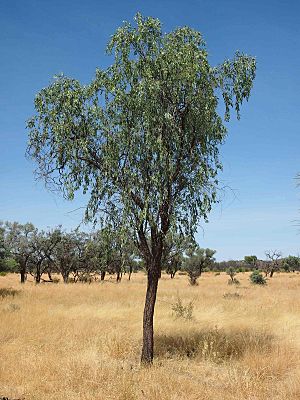Northern sandalwood facts for kids
Quick facts for kids Northern sandalwood |
|
|---|---|
 |
|
| Scientific classification | |
| Genus: |
Santalum
|
| Species: |
lanceolatum
|
Santalum lanceolatum is an interesting Australian tree. It belongs to the Santalaceae family, which includes many types of sandalwood. People often call this tree by different names like desert quandong, northern sandalwood, sandalwood, or true sandalwood. In some areas, it's also known as burdardu.
This tree can grow to different heights, usually between 1 and 7 meters (about 3 to 23 feet) tall. Its flowers are a mix of green, white, and cream colors, and they bloom for a long time, from January all the way through October. You can find Santalum lanceolatum mostly in central Australia. It becomes less common as you go further south.
Contents
About the Santalum lanceolatum Tree
How it was Named
A scientist named Robert Brown officially described this tree in 1810. He wrote about it in a book called Prodromus Florae Novae Hollandiae.
Where it Grows
This tree grows naturally across a large part of Australia. You can find it from north-western Victoria, up through New South Wales to North Queensland. It also grows west into the Northern Territory and north-western Western Australia.
Santalum lanceolatum mostly lives in dry, inland areas. These are called arid and semi-arid regions. However, you can also find it near the coast in places like Central Queensland and the Kimberley. Sadly, in some desert areas, there are too many wild camels eating these trees. This makes the trees harder to find.
How it Lives
The Santalaceae family, which Santalum lanceolatum belongs to, is related to mistletoe. This tree is a "hemi-parasite." This means it gets some of its water and important nutrients from the roots of other plants. It's like a plant that borrows food and water from its neighbors!
Medicinal Uses
The Aboriginal people of northwest Australia use this plant for many medicinal purposes. It is even part of their special 'Burndad song cycle'. In the Marra language, they call it dumbuyumbu. This name is also used in nearby languages like Alawa and in Kriol spoken around the Roper River.
People also burn the leaves of this tree. The smoke helps to keep insects away.
See also
 In Spanish: Santalum lanceolatum para niños
In Spanish: Santalum lanceolatum para niños
Images for kids


